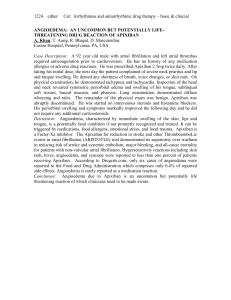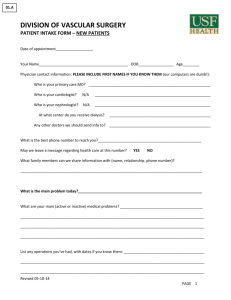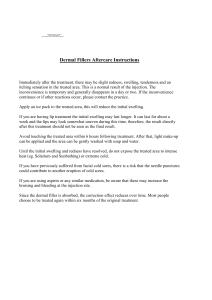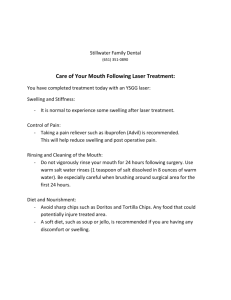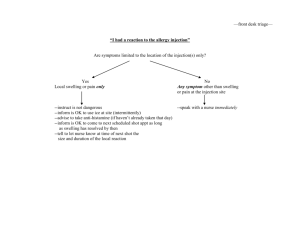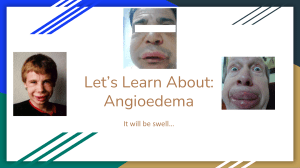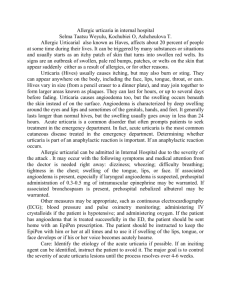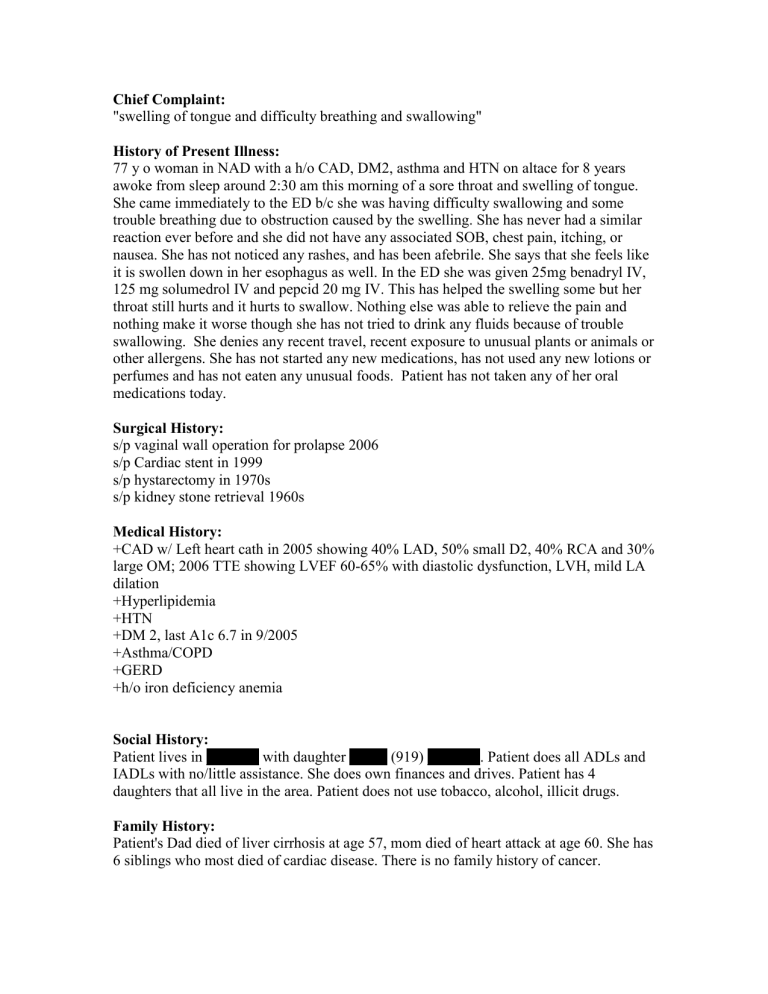
Chief Complaint: "swelling of tongue and difficulty breathing and swallowing" History of Present Illness: 77 y o woman in NAD with a h/o CAD, DM2, asthma and HTN on altace for 8 years awoke from sleep around 2:30 am this morning of a sore throat and swelling of tongue. She came immediately to the ED b/c she was having difficulty swallowing and some trouble breathing due to obstruction caused by the swelling. She has never had a similar reaction ever before and she did not have any associated SOB, chest pain, itching, or nausea. She has not noticed any rashes, and has been afebrile. She says that she feels like it is swollen down in her esophagus as well. In the ED she was given 25mg benadryl IV, 125 mg solumedrol IV and pepcid 20 mg IV. This has helped the swelling some but her throat still hurts and it hurts to swallow. Nothing else was able to relieve the pain and nothing make it worse though she has not tried to drink any fluids because of trouble swallowing. She denies any recent travel, recent exposure to unusual plants or animals or other allergens. She has not started any new medications, has not used any new lotions or perfumes and has not eaten any unusual foods. Patient has not taken any of her oral medications today. Surgical History: s/p vaginal wall operation for prolapse 2006 s/p Cardiac stent in 1999 s/p hystarectomy in 1970s s/p kidney stone retrieval 1960s Medical History: +CAD w/ Left heart cath in 2005 showing 40% LAD, 50% small D2, 40% RCA and 30% large OM; 2006 TTE showing LVEF 60-65% with diastolic dysfunction, LVH, mild LA dilation +Hyperlipidemia +HTN +DM 2, last A1c 6.7 in 9/2005 +Asthma/COPD +GERD +h/o iron deficiency anemia Social History: Patient lives in _______ with daughter _____ (919) _______. Patient does all ADLs and IADLs with no/little assistance. She does own finances and drives. Patient has 4 daughters that all live in the area. Patient does not use tobacco, alcohol, illicit drugs. Family History: Patient's Dad died of liver cirrhosis at age 57, mom died of heart attack at age 60. She has 6 siblings who most died of cardiac disease. There is no family history of cancer. Allergies: Sulfa drugs - rash Cipro - rash Benadryl – causes mild dystonic reaction Medications: Theophyline (Uniphyl) 600 mg qhs – bronchodilator by increasing cAMP used for treating asthma Diltiazem 300 mg qhs – Ca channel blocker used to control hypertension Simvistatin (Zocor) 20 mg qhs- HMGCo Reductase inhibitor for hypercholesterolemia Ramipril (Altace) 10 mg BID – ACEI for hypertension and diabetes for renal protective effect Glipizide 5 mg BID (diabetes) – sulfonylurea for treatment of diabetes Omecprazole (Prilosec) 20 mg daily (reflux) – PPI for treatment of ulcers Gabapentin (Neurontin) 100 mg qhs – modulates release of neurotransmitters to treat diabetic neuropathy Metformin 500 mg qam – biguanide used to treat diabetes Aspirin 81 mg qam - prophylaxis for MI and TIA Servant 1puff bid Fluticasone (Flovent) 2 puff bid - corticosteroid to treat airways in asthma/copd xoperex 1.25mg and Ipratropium 2.5 ml nebulized qam - anticholinergic to treat airways in COPD Review of Systems: Constitutional - NAD, has been generally feeling well the last couple of weeks Eyes - no changes in vision, double vision, blurry vision, wears glasses ENT - No congestion, changes in hearing, does not wear hearing aids Skin/Breast - no rashes Cardiovascular - No SOB, chest pain, heart palpitations Pulmonary - hard to get a breath in but not short of breath, no cough Endocrine - No changes in appetite Gastro Intestinal - No n/v/d or constipation. Has not eaten because can't swallow solid foods. Genito Urinary - No increased frequency or pain on urination. Some urge incontinence with history of prolapse. Musculo Skeletal - no changes in strengths, no joint tenderness or swelling Neurologic - No changes in memory Psychology - No changes in mood Heme/Lymph - Denies easy bruising Physical Examination: Vitals: Temp 35.9 Pulse 76 O2 98% RA RR 20 BP 159/111 General - NAD, sitting up in bed, well groomed and in nightgown Eyes - PERRLA, EOM intact ENT - Large swollen tounge and cheek on left side, tounge was large and obscured the view of the posterior oropharynx Neck - No noticeable or palpable swelling, redness or rash around throat or on face Lymph Nodes - No lymphadenopathy Cardiovascular - RRR no m/r/g, no JVD, no carotid bruits Lungs - Clear to auscltation, no use of acessory muscles, no crackles or wheezes. Skin - No rashes, skin warm and dry, no erythematous areas Breast Psychiatry Abdomen - Normal bowel sounds, abdomen soft and nontender Genito Urinary – Genital exam not performed since complaints not related. Rectal – Rectal exam not performed since no symptoms indicated blood loss. Extremeties - No edema, cyanosis or clubbing Musculo Skeletal - 5/5 strength, normal range of motion, no swollen or erythematous joints. Neurological – Alert and oriented x 3, CN 2-12 grossly intact. Pertinent Diagnostic Tests: Na 140 K 4.5 Cl 109 Co2 23 BUN 29 Cr 1.0 Ca 9.9 Mg 1.4 Phos 3.6 PTT 26.7 WBC 9.9 Hgb 10.0 Hct 30.3 Plt 373 EKG - no signs of ischemia Assessment and Plan: 77 yo woman presents with significant angioedema in left side of tongue and inner cheek. Possible causes of angioedema include allergic anaphylaxis reaction, drug induced, allergic contact dermatitis, viral infection, drug induced, or a C1 inhibitor deficiency disorder acquired or hereditary. Laryngeal edema can also be caused by tonsillitis, peritonsilar abscess or pharyngeal foreign body. It is unlikely that the patient has edema caused by abscess or tonsillitis since she does not have any associated fever or other signs of infection and the sudden onset of her swelling also argues against this. It is not likely a foreign body since ENT did not find anything when they scoped her. It is unlikely that it is caused by a mast cell mediated etiologigy that increases vascular permeability through mast cell degranulation and release of inflammatory mediators include allergic angioedema, autoimmune mast cell release and direct mast cell release caused by medications such as opiates and radiocontrast media. It is not likely this type of reaction because these etiologies are associated with urticaria and pruritis, which the patient did not have. Also the patient did not have any exposure to a new pet, food, lotion or any other allergen or medication that could cause an allergic type reaction. The patient also does not have any history of autoimmune disease or any reaction similar to this in the past It is more likely that the etiology is kinin-related where angioedema results from generation of bradykinin and complement-derived mediators that increase vascular permeability since there is no urticaria or pruritis. The most likely cause is the Altace (ACEI) that the patient has been taking caused an increase in bradykinin since it decreases angiotensin 2 which degrades bradykinin. Bradykinin can then interact with vascular receptors increasing vasodilation, vascular permeability, increased cGMP and release of nitric oxide. This reaction occurs in .1-7% of patients treated with an ACEI and it typically involves the mouth, lips, tounge, larynx, pharynx and sublottic tissues. Half of these cases usually occur within a week of starting the ACEI but can occur years later. This is a class specific reaction not a drug specific and ARBs can cause the same reaction even though these drugs don’t effect the kinin metabolism. 50% of patients with angioedema due to an ARB also had an ACEI induced angioedema (Cicardi, M, Zingale, LC, Bergamschini L, Agostoni, A. Angioedema associated with agniotensin-converting enzyme inhibitor use: outcome after switching to a different treatment. Arch Intern Med 2004; 164:910). Deficiency of C1 inhibitor can cause angioedema since levels of complement are reduced and cause increased bradykinin. This can be due to lack of C1 INH or adequate amounts of nonfunctional C1 INH. Other causes of angioedema include aspirin and NSAIDs since inhibition of cox and enzyme pathyway increases formation of pro-inflammatory leukotrienes. Other possibilities in the differential of causes of swelling include cellulitis, autoimmune conditions including SLE, polymyositis, dermatomyositis and sjorgren’s syndrome. Hypothyroidism can cuase puffiness of face and lips, hyperthyroidism can cause an infiltrative dermopathy, superior vena cava syndrome and tumors can cause venous engorgement and swelling. It is not likely one of these etiologies since the patient is on an ACEI and the swelling is restricted only to her tongue and throat typical of ACEI angioedema. Plan: ++Swollen tongue: - Give patient corticosteroid to decrease inflammation and to protect against relapse after initial improvement. 4 days of Dexamethasone 10 mg IV tid. - Give patient antihistamine to block inflammation as well. 4 days of Diphenhydramine 25 mg bid. - ENT consult to rule out abscess or foreign object - Check C1 and C4 levels that would be decreased if the patient had C1 inhibitory complement deficiency - TSH level to check for hypo/hyper thyroid - Hold all oral home meds and keep patient NPO until airway swelling is reduced and patient can swallow easily ++Asthma/COPD - continue albuterol and ipratropium nebs prn - resume theophylline when patient can take oral meds ++DM - Not on oral home meds - Patient is on corticosteroids that increase blood glucose levels, so put patient on sliding scale normal insulin to adjust for high sugars - Resume neurontin for neuropathy when oral meds can be taken ++HTN - Continue patient’s BP control with Diltiazem drip 5mg/hour - HOLD altace (ACEI) that is most likely the cause of angioedema - Consider an alternative HTN medication to replace the ACEI. Can’t use a HCTZ because of sulfa allergy. Also has asthma/COPD picture so beta blocker may not work well either. ++CAD s/p PCI in 1999 - Resume simvastatin and aspirin when patient is able to take oral meds ++GERD - famotidine when oral meds are resumed
